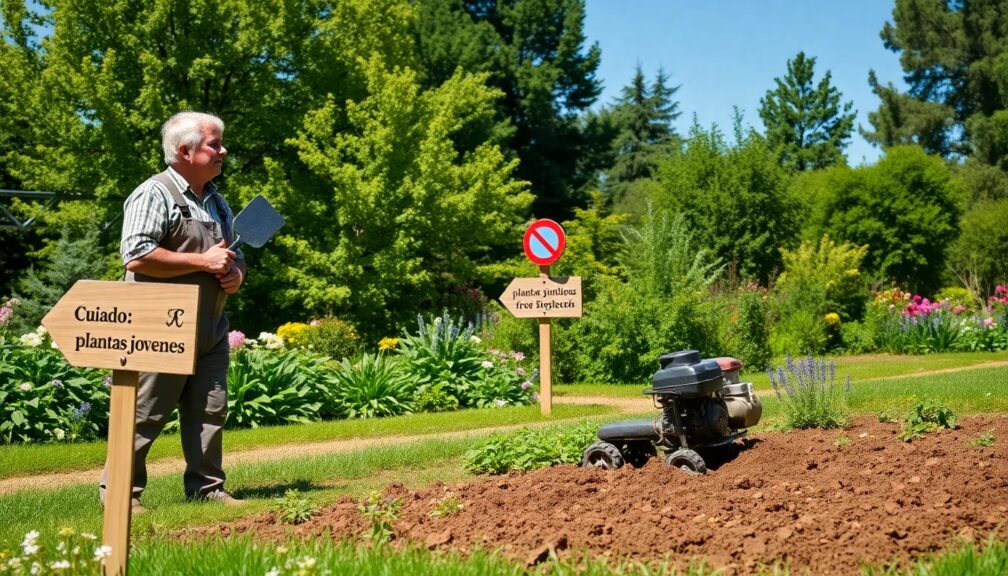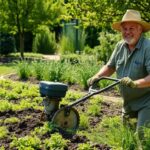When not to use a tiller

Welcome to Our Article on When Not to Use a Tiller
Gardening enthusiasts and farmers alike understand the importance of cultivating soil to encourage plant growth. A tiller, a powerful tool designed to break up hard soil and mix in nutrients, can be immensely helpful in preparing garden beds and crop rows. However, there are specific circumstances where using a tiller can do more harm than good. This article delves into the critical times and situations when the cons of tilling outweigh the pros, guiding you to make informed decisions for optimal soil health and garden vitality. Whether you're a seasoned green thumb or a budding gardener, understanding when not to wield this robust instrument is paramount in fostering a flourishing and sustainable growing environment.
When not to use a rototiller?
Imagine nurturing a garden that’s the envy of the neighborhood – lush, vibrant, and bursting with life. Now, picture tearing through that delicate ecosystem with a machine that could potentially do more harm than good. That’s the risk you run when you grab for the rototiller without considering the consequences. It’s essential to know the right time and right place to use this powerful tool, or you might just miss out on maximizing your garden's potential.
Using a rototiller can sometimes be akin to taking a sledgehammer to crack a nut – it’s overkill and can be destructive. For instance, if the soil structure is already fine and crumbly, the rototiller can destroy the delicate balance of your soil, leading to compaction and loss of beneficial organisms.
1. Soil Health: The intricate web of life beneath our feet is a cornerstone of any thriving garden. Over-tilling can decimate earthworm populations and microbial life, which are crucial for nutrient cycling and aeration. If creating a biodiverse haven is your goal, think twice before you till.
2. Young Plants and Roots: Have you ever seen the aftermath of a bulldozer in a wild meadow? That’s what a rototiller can feel like to the young plants and delicate root systems in your garden. Tilling can slice and dice through root systems, disrupting plant growth and potentially setting your garden back weeks or even months.
3. Weed Proliferation: You might think you’re winning the battle against weeds by tilling, but you could be unwittingly sowing the seeds of your future troubles. Many weeds are adept at regenerating from root fragments; tilling can spread these fragments throughout your garden, inviting a weed explosion that no gardener wants to contend with.
4. Dry Conditions: In the grip of a dry spell? Tilling can exacerbate the situation, causing precious moisture to evaporate from the soil. This can lead to a harsh, dry environment where only the hardiest plants will survive, and certainly not the verdant oasis you were hoping for.
The lure of quick and easy soil preparation can be strong, but the fallout from improper use of a rototiller can haunt your garden for seasons to come. By respecting the land and understanding the intricate dance between soil, plant, and machine, you can ensure your garden remains a thriving ecosystem. Don't let curiosity or impatience lead you to make a decision you’ll regret. There’s a time for tilling, and plenty of times not to – knowing the difference could be the key to your horticultural success.
Make sure to continue your journey to becoming a garden guru by learning not just when, but why and how to choose alternatives to the rototiller. Your garden will thank you, and your neighbors will wonder how you managed to cultivate such a flourishing paradise. The secret? Sometimes, it’s the tools you don’t use that make all the difference.
What are the disadvantages of a tiller?
Tillers, while instrumental in breaking up soil and preparing garden beds, come with a set of drawbacks that could make any gardener think twice. Understanding these shortcomings is crucial, especially when optimal soil health and management efficiency are at stake.
Firstly, consider the issue of physical strain. Operating a tiller requires significant effort, and for larger plots, this can lead to fatigue or even injury. The constant vibration and the need to control the machine's movement put stress on the arms and back, which is something to seriously mull over for those with physical limitations or health concerns.
Next, there's the soil compaction paradox. Counterintuitively, tillers, which are meant to aerate, can actually cause compaction deeper in the soil. This hidden problem might go unnoticed at first, but over time, it can lead to decreased water infiltration and root growth, a dilemma no gardener wants to encounter.
Another key disadvantage is the disruption of soil ecosystems. Tillers can decimate the microorganisms and earthworms that are essential for a healthy soil food web. This assault on biodiversity not only affects soil structure and nutrient cycling but can also make your garden more vulnerable to pests and diseases.
Moreover, tillers are not discriminate in their action. They often churn up weeds, spreading weed seeds throughout your garden and potentially leading to even more weeding in the future. It's like taking one step forward and two steps back in your quest for a weed-free paradise.
And let's talk about cost and maintenance. A tiller is not a small investment, and it demands regular upkeep. From sharpening blades to engine maintenance, the costs can add up, making it a less attractive option for those on a tight budget or with limited time for upkeep.
Finally, consider the environmental impact. Traditional tillers are powered by gas, contributing to carbon emissions and noise pollution. If you're someone who values eco-friendly gardening practices, this point alone might steer you toward alternative soil preparation methods.
These insights are just the tip of the iceberg. To fully understand the implications of using a tiller and explore possible solutions, stay tuned for our comprehensive guide, where we dive deeper into each disadvantage and offer expert tips on how to mitigate these issues or even avoid them altogether. Don't miss out on transforming your gardening experience with informed choices that benefit you and your garden's ecosystem.
Why shouldn't you till your garden?
Unearth the secrets behind the no-till movement and discover how skipping this traditional gardening step could be the game-changer your garden has been waiting for.
1. Preserving Soil Structure: Tilling might seem like the best way to prepare your garden bed, but have you considered its impact on the delicate soil ecosystem? The layers of earth house diverse organisms vital for plant health. Learn why keeping these layers intact is crucial.
2. Protecting Microbial Life: The soil is teeming with beneficial microbes that play a pivotal role in nutrient cycling. Delve into the microscopic world and find out how tilling can disrupt these tiny, yet mighty, allies.
3. Reducing Erosion: Your garden's soil is prone to erosion with each tilling pass. We uncover the surprising ways no-till gardening can safeguard your soil against wind and water erosion.
4. Moisture Retention: Struggle with keeping your garden hydrated? Tilling could be aggravating the problem. We'll show you how no-till methods can help your garden retain moisture and reduce the need for frequent watering.
5. Weed Management: The war against weeds is a gardener's tale as old as time. But what if tilling is actually giving weeds an advantage? Uncover the strategies that could help you outsmart these persistent invaders for good.
6. Carbon Sequestration: In an era of climate awareness, every action counts. Discover the surprising connection between your garden and global carbon levels. Can no-till gardening really make a difference? The answer might inspire you.
By turning the page on tilling, you're not just stepping into a new gardening paradigm; you're potentially stepping up the resilience and productivity of your garden. Get ready to challenge what you know and transform your approach for the better. The revelations within may just lead to your most thriving garden yet, and the excitement of discovering these gardening truths could be the very thing your green thumb has been searching for.
Does tilling cause more weeds?
Many gardeners and farmers swear by tilling as a means to prepare their land for planting, but what if this age-old practice is actually counterproductive in the long run? The truth might surprise you, and it's a topic that's generating buzz among those with a green thumb.
First off, it's essential to understand that tilling is the process of turning over the soil to aerate it and incorporate organic matter. However, this disruption can have unintended consequences. When you till, dormant weed seeds that were buried and unable to germinate suddenly find themselves closer to the soil surface. In this prime location, they receive the light and air needed to sprout, potentially leading to a proliferation of weeds.
But that's just the tip of the iceberg. In the tilling process, you also disrupt the soil structure, affecting its ability to retain water and nutrients. This can create an environment that's even more conducive to weed growth, as weeds are often more adept at thriving in less-than-ideal conditions than your carefully selected plants.
You might be thinking, "There has to be more to the story," and you're right. The implications of tilling on weed growth are surrounded by a debate that delves into soil health, ecosystem balance, and long-term sustainability.
To grasp the full spectrum of effects, consider the following points:
1. Soil Ecosystem: Tilling can disrupt the delicate balance of the soil ecosystem, destroying beneficial microorganisms that help suppress weed growth.
2. Sustainability: Frequent tilling may lead to soil erosion and degradation, making land less productive over time and potentially increasing reliance on chemical weed control methods.
3. Alternatives: No-till or reduced-till farming practices are gaining traction, highlighting methods that could mitigate weed issues without the downsides of traditional tilling.
Are you ready to challenge the status quo and delve deeper into the complexities of soil management? The journey into the relationship between tilling and weed proliferation is a fascinating one, filled with unexpected twists and turns that could reshape the way you approach gardening or farming. Stay tuned as we uncover the layers of this intricate puzzle, and prepare to be captivated by the science that could revolutionize our interaction with the earth beneath our feet.
When not to use a tiller reddit
Have you ever felt the itch to turn over your garden soil, armed with the mechanical might of a tiller? Before you rev up that engine, take heed—there are critical moments when this powerful tool should remain in the shed, and neglecting this wisdom could spell disaster for your garden's health and productivity.
Understanding Soil Structure
Unbeknownst to many enthusiastic gardeners is the delicate balance of the soil's ecosystem. Overzealous tilling can annihilate beneficial microorganisms and earthworms, not to mention the havoc it wreaks on the soil's structure. The result? A compacted, lifeless environment where plants struggle to thrive.
Tiller Timing
Timing is everything. The eager gardener might not realize that tilling wet soil is a cardinal sin, as it leads to severe clumping and compaction. Conversely, waiting for the perfect moisture level can transform your tilling into an effortless dance rather than a battle against the clods.
Organic Matter
The incorporation of organic matter is the lifeblood of fertile soil. Yet, excessive tilling can bury this matter too deeply, depriving surface-dwelling organisms of their sustenance and disrupting the natural layering that plants have adapted to exploit. The key is to know when to let nature take its course.
Root Crops
Imagine your dismay upon discovering that your tiller has sliced through the very crops you've been nurturing. Potatoes, carrots, and other root vegetables are particularly susceptible to being damaged by tilling, reminding us that sometimes our tools can become our enemies.
Soil Erosion
The sight of precious topsoil being washed or blown away is enough to bring a gardener to tears. Yet, without the protective blanket of plant cover, tilled soil is left vulnerable to the elements. It's a stark warning that sometimes, leaving the soil undisturbed is the best defense against erosion.
As you stand at the crossroads of garden maintenance, pondering whether to till or not to till, remember that the stakes are high. The health of your soil, the vigor of your plants, and the balance of your garden's ecosystem hang in the balance. Make the wise choice, and your garden will thank you with a bounty that's surely worth the wait. Curious to know more? The rabbit hole of garden do's and don'ts is deep, and the insights are endlessly fascinating. Don't let your garden down by missing out on this crucial knowledge.
Consejo final: Caution should be exercised when considering the use of a tiller. Refrain from using it on soil that is too wet or dry, as this can damage both the tiller and the soil structure. Additionally, avoid tilling during the growing season to prevent disruption of plant roots and beneficial soil organisms. Take care to preserve the health of your garden ecosystem for sustainable growth. Wishing you a flourishing garden with mindful cultivation practices.
 Can you till a garden with a cultivator
Can you till a garden with a cultivator Will a tiller till up grass
Will a tiller till up grass How do you loosen hard soil without a tiller
How do you loosen hard soil without a tiller How do you loosen soil without hurting roots
How do you loosen soil without hurting roots What softens hard soil
What softens hard soilIf you want to know more about similar articles like When not to use a tiller you can visit category Gardening Tools.
Deja una respuesta